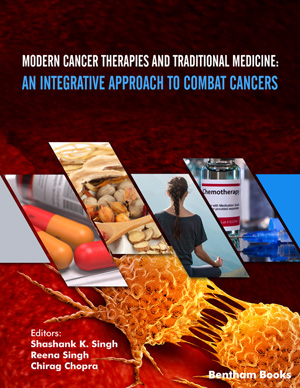
Abstract
Background: Worldwide, cancer patients are facing problems with life-and-death decisions due to the associated severe adverse and sometimes fatal effects of existing conventional treatments. Due to the severe adverse effects of existing therapies, effective cures are progressively explored for anticancer treatment. Mostly the conventional therapies are based upon nonspecific cellular destruction properties; therefore, a treatment approach is desired to reduce the toxic burden upon normal tissues. Among all alternative medicine systems, homeopathy is one of the most popular treatments for cancer patients globally due to its minimal side effects.
Methods: In this present review, we have attempted to comprehend the literature reports on homeopathic medicine in cancer treatment.
Results: Homeopathy has also proved its adjuvant approach to minimizing the symptomatic consequences of cancer. However, the insufficiency of evidence and lack of recurrence of the trials cause difficulty in drawing any conclusion about homeopathy as adjuvant therapy. Based upon the etiology, the genoprotective potential of homeopathic drugs was reviewed and found inconsequential evaluation and scanty literature.
Conclusion: Hence, the present review gives a comprehensive summary of retrospective studies and suggests an integration of rational drug selection, standard protocols, and quantitative analysis for revealing the differential role and plausible application of homeopathy in better cancer management.
Keywords: Cancer, radiotherapy, chemotherapy, adjuvant, complementary and alternative medicines (CAM).
Graphical Abstract
[http://dx.doi.org/10.1016/S2214-109X(16)30143-7] [PMID: 27470177]
[http://dx.doi.org/10.1155/2013/815105] [PMID: 23970972]
[http://dx.doi.org/10.1080/17425255.2016.1190831] [PMID: 27187715]
[http://dx.doi.org/10.1038/s41698-017-0034-x] [PMID: 29872712]
[http://dx.doi.org/10.1038/nrclinonc.2015.152] [PMID: 26391778]
[http://dx.doi.org/10.1016/j.pharmthera.2016.02.008] [PMID: 26899500]
[http://dx.doi.org/10.1097/MD.0000000000004766] [PMID: 27611935]
[http://dx.doi.org/10.1038/nrc2587] [PMID: 19148183]
[http://dx.doi.org/10.1038/nrd4003] [PMID: 23812271]
[http://dx.doi.org/10.1158/1078-0432.CCR-15-1846] [PMID: 26429991]
[http://dx.doi.org/10.1007/s00280-017-3501-8] [PMID: 29249039]
[http://dx.doi.org/10.3322/canjclin.55.2.117] [PMID: 15761080]
[http://dx.doi.org/10.1016/j.fitote.2003.07.008] [PMID: 14693216]
[http://dx.doi.org/10.4172/2161-0495.1000139]
[http://dx.doi.org/10.1093/mutage/gev026] [PMID: 25863274]
[http://dx.doi.org/10.1002/em.22118] [PMID: 28766757]
[http://dx.doi.org/10.1016/j.mrgentox.2013.08.009] [PMID: 24004877]
[http://dx.doi.org/10.1053/j.seminoncol.2003.11.014] [PMID: 14727237]
[http://dx.doi.org/10.1021/acs.jmedchem.5b01628] [PMID: 26978566]
[http://dx.doi.org/10.1177/1534735406294794] [PMID: 17101761]
[http://dx.doi.org/10.1159/000124976] [PMID: 18550913]
[http://dx.doi.org/10.1016/j.jams.2013.04.004] [PMID: 23972240]
[http://dx.doi.org/10.1089/acm.2005.11.839] [PMID: 16296917]
[http://dx.doi.org/10.1016/j.homp.2017.09.001] [PMID: 29157470]
[http://dx.doi.org/10.1054/homp.1999.0364] [PMID: 10826447]
[http://dx.doi.org/10.3736/jintegrmed2013014] [PMID: 23506692]
[http://dx.doi.org/10.1016/j.homp.2014.11.004] [PMID: 26143455]
[http://dx.doi.org/10.3892/ijo.23.4.975] [PMID: 12963976]
[PMID: 18159975]
[PMID: 7008932]
[http://dx.doi.org/10.1016/j.biocel.2007.07.002] [PMID: 17709275]
[http://dx.doi.org/10.1186/1748-717X-5-85] [PMID: 20868468]
[PMID: 12782571]
[http://dx.doi.org/10.1016/0360-3016(95)00214-8] [PMID: 7591884]
[http://dx.doi.org/10.1023/A:1009675028784] [PMID: 14634289]
[http://dx.doi.org/10.1038/nrc2615] [PMID: 19343035]
[http://dx.doi.org/10.3389/fmolb.2014.00024] [PMID: 25988165]
[http://dx.doi.org/10.2174/156800906777723976] [PMID: 16918311]
[http://dx.doi.org/10.1371/journal.pone.0014195] [PMID: 21152027]
[http://dx.doi.org/10.1016/j.rpor.2019.02.003] [PMID: 30858768]
[http://dx.doi.org/10.1016/j.rpor.2015.05.010] [PMID: 26549990]
[http://dx.doi.org/10.1002/clc.22634] [PMID: 28139844]
[http://dx.doi.org/10.1158/0008-5472.CAN-07-6611] [PMID: 18974103]
[http://dx.doi.org/10.1038/nrclinonc.2012.203] [PMID: 23183635]
[http://dx.doi.org/10.1016/j.dnarep.2011.10.019] [PMID: 22051193]
[http://dx.doi.org/10.7150/ijms.3635] [PMID: 22408567]
[http://dx.doi.org/10.1590/S1415-475738420150019] [PMID: 26692152]
[http://dx.doi.org/10.1158/0008-5472.CAN-14-3247] [PMID: 25931285]
[http://dx.doi.org/10.21037/tcr.2017.06.02]
[http://dx.doi.org/10.1016/0165-1110(94)90015-9] [PMID: 7527485]
[http://dx.doi.org/10.1080/00039896.1994.9940377] [PMID: 8185386]
[PMID: 7306965]
[http://dx.doi.org/10.4061/2010/543531] [PMID: 21113301]
[http://dx.doi.org/10.1016/j.bbcan.2017.01.004] [PMID: 28143714]
[http://dx.doi.org/10.2174/1874467211205010102] [PMID: 22122467]
[http://dx.doi.org/10.6061/clinics/2018/e478s] [PMID: 30208165]
[http://dx.doi.org/10.1016/j.chembiol.2014.11.013] [PMID: 25579208]
[http://dx.doi.org/10.1124/mol.115.100164] [PMID: 26494862]
[http://dx.doi.org/10.1101/cshperspect.a016428] [PMID: 25104768]
[http://dx.doi.org/10.1371/journal.pbio.1000091] [PMID: 19402749]
[http://dx.doi.org/10.1038/nrc2607] [PMID: 19377506]
[http://dx.doi.org/10.1016/j.chembiol.2010.04.012] [PMID: 20534341]
[http://dx.doi.org/10.4103/0973-1482.139267] [PMID: 25579518]
[http://dx.doi.org/10.1021/mp900243b] [PMID: 20108971]
[PMID: 12907603]
[PMID: 13950199]
[http://dx.doi.org/10.7326/0003-4819-87-3-293] [PMID: 71004]
[PMID: 6167346]
[http://dx.doi.org/10.3390/cancers3033279] [PMID: 24212956]
[http://dx.doi.org/10.1158/0008-5472.CAN-17-2782] [PMID: 29311160]
[http://dx.doi.org/10.1038/nrc2342] [PMID: 18256616]
[http://dx.doi.org/10.1002/tcm.1770050502] [PMID: 2867614]
[http://dx.doi.org/10.3390/ijms15033403] [PMID: 24573252]
[http://dx.doi.org/10.1007/BF00351132] [PMID: 22358450]
[PMID: 9806010]
[http://dx.doi.org/10.1016/B978-0-7020-4336-9.00016-0]
[http://dx.doi.org/10.1016/j.jnim.2015.12.332]
[http://dx.doi.org/10.4172/2161-0444.1000252]
[http://dx.doi.org/10.5099/aj130300171]
[http://dx.doi.org/10.4161/cc.3.8.1023] [PMID: 15254418]
[http://dx.doi.org/10.1093/oxfordjournals.jncimonographs.a003451] [PMID: 11773307]
[http://dx.doi.org/10.1007/s11596-014-1340-y] [PMID: 25318881]
[http://dx.doi.org/10.1046/j.1523-5394.1998.1998006013.x] [PMID: 9460322]
[PMID: 1394186]
[http://dx.doi.org/10.1038/nrclinonc.2009.146] [PMID: 19786984]
[http://dx.doi.org/10.1002/tcm.1035] [PMID: 11754384]
[http://dx.doi.org/10.1016/j.mrfmmm.2007.11.008] [PMID: 18207203]
[http://dx.doi.org/10.1007/BF00684887] [PMID: 2295114]
[http://dx.doi.org/10.1074/jbc.M400944200] [PMID: 15054096]
[http://dx.doi.org/10.1038/s41598-018-34580-8] [PMID: 30410071]
[http://dx.doi.org/10.1097/FPC.0b013e32833ffb56] [PMID: 21048526]
[http://dx.doi.org/10.1093/mutage/gey014] [PMID: 30239865]
[http://dx.doi.org/10.3390/antiox5030022] [PMID: 27399787]
[http://dx.doi.org/10.18632/oncotarget.16723] [PMID: 28410237]
[http://dx.doi.org/10.1038/s41392-017-0004-3] [PMID: 29560283]
[http://dx.doi.org/10.1038/bjc.2015.56] [PMID: 25668005]
[http://dx.doi.org/10.1186/s13045-016-0365-z] [PMID: 27938382]
[http://dx.doi.org/10.1155/2012/282570] [PMID: 23320169]
[http://dx.doi.org/10.1016/S2095-4964(15)60201-1] [PMID: 26559365]
[http://dx.doi.org/10.1159/000499629] [PMID: 31132779]
[http://dx.doi.org/10.1177/1534735416643384] [PMID: 27151586]
[PMID: 18471036]
[PMID: 12811673]
[http://dx.doi.org/10.1055/s-0038-1654692]
[http://dx.doi.org/10.1016/j.explore.2015.02.013] [PMID: 25835350]
[http://dx.doi.org/10.1191/0269216302pm539oa] [PMID: 12046999]
[http://dx.doi.org/10.3390/curroncol14040004] [PMID: 17710204]
[http://dx.doi.org/10.1007/s11912-015-0467-8] [PMID: 26210222]
[http://dx.doi.org/10.1093/ecam/nem067] [PMID: 18955221]
[http://dx.doi.org/10.1177/1534735406295350] [PMID: 17101766]
[http://dx.doi.org/10.1016/j.homp.2010.05.008] [PMID: 20674840]
[http://dx.doi.org/10.1007/s11010-005-9065-7] [PMID: 16538399]
[PMID: 19761046]
[http://dx.doi.org/10.1093/ecam/neq042] [PMID: 21647317]
[http://dx.doi.org/10.3892/or.2014.2993] [PMID: 24482097]
[PMID: 17477781]
[http://dx.doi.org/10.1016/S2095-4964(16)60251-0] [PMID: 27181128]
[http://dx.doi.org/10.4103/0973-1296.139792] [PMID: 25298670]
[http://dx.doi.org/10.5667/tang.2012.0044]
[http://dx.doi.org/10.3892/ijo.2015.3061] [PMID: 26095308]
[http://dx.doi.org/10.1186/bcr1807]
[http://dx.doi.org/10.1055/s-0040-1716369] [PMID: 33348419]
[http://dx.doi.org/10.1002/14651858.CD004845.pub2] [PMID: 19370613]
[http://dx.doi.org/10.1186/1471-2407-11-19]
[http://dx.doi.org/10.1054/homp.1999.0328] [PMID: 10703904]
[http://dx.doi.org/10.1200/JCO.2004.07.063] [PMID: 15084618]
[http://dx.doi.org/10.1002/1097-0142(20010801)92:3<684::AID-CNCR1371>3.0.CO;2-#] [PMID: 11505416]
[http://dx.doi.org/10.5455/jice.20161229055245] [PMID: 28163953]
[http://dx.doi.org/10.1016/j.ctim.2015.03.004] [PMID: 26051564]
[http://dx.doi.org/10.1186/1471-2407-11-19] [PMID: 21241504]
[http://dx.doi.org/10.1001/archsurg.133.11.1187] [PMID: 9820349]
[http://dx.doi.org/10.1136/vr.103779] [PMID: 27956476]
[http://dx.doi.org/10.1002/onco.13548] [PMID: 33010094]
[http://dx.doi.org/10.3390/nu11020459]
[http://dx.doi.org/10.1177/1534735405282251] [PMID: 16282509]
[http://dx.doi.org/10.3736/jintegrmed2013054] [PMID: 24299603]
[http://dx.doi.org/10.1016/j.colsurfb.2012.07.008] [PMID: 23010037]
[http://dx.doi.org/10.1016/S0891-5849(00)00360-9] [PMID: 11025194]
[PMID: 11131669]
[PMID: 19256773]
[http://dx.doi.org/10.3736/jcim20120314] [PMID: 22409925]
[http://dx.doi.org/10.1016/S0007-0785(05)80544-7]
[http://dx.doi.org/10.5667/tang.2013.0015]
[http://dx.doi.org/10.1039/9781847559746]
[http://dx.doi.org/10.3109/10715762.2015.1071485] [PMID: 26156438]
[http://dx.doi.org/10.1038/s41598-018-24440-w] [PMID: 29666389]
[http://dx.doi.org/10.1016/j.fct.2012.09.002] [PMID: 22982473]
[PMID: 30658031]























